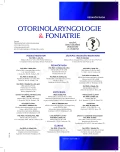The Survey of Implants for Bone-Conducted Hearing and Active Middle Ear Implants
Authors:
J. Skřivan
Authors‘ workplace:
Klinika ušní, nosní a krční 2. LF UK a FN Motol, Praha
Published in:
Otorinolaryngol Foniatr, 67, 2018, No. 3, pp. 68-74.
Category:
Review Article
Overview
Implants for bone-conducted hearing and active middle ear implants transfer information about sound and speech to middle ear in the form of vibrations. Vibrations quiver inner ear fluids, stimulate the hair cells and evoke the sound percepts. That is how they differ from cochlear implants, which stimulate nervous structures by electric impulses. The implant for bone-conducted hearing transfers vibrations into the skull bones, whereas the active middle ear implant transfers the vibrations aiming at midle ear structure (middle ear ossicles, oval window membrane).
Keywords:
ear, middle ear, hearing, bone-conducted hearing
Sources
1. Böheim, K.: Active middle ear implants. Karger, Basel, 2010.
2. Bouček, J., Vokřál, J., Černý, L., Chovanec, M., Čada, Z., Zábrodský, M., Zvěřina, E., Betka, J., Skřivan, J.: Baha jako možné řešení jednostranné hluchoty. Cesk. Slov. Neurol. N, 79/112, 2016, 3, s. 324-330.
3. Kompis, M., Caversaccio, M. D.: Implantable bone conduction hearing aids. Karger Medical and Scientific Publishers, Basel, 2011.
4. Lenarz, T., Schwab, B., Maier, H., Kludt, E.: Direct acoustic cochlear stimulation for therapy of severe to profound mixed hearing loss. Codacs Direct Acoustic Cochlear Implant System. HNO, 62, 2014, č. 7, s. 481-489.
5. Reinfeldt, S., Håkanson, B., Taghavi, H., Eeg-Olofsson, M.: New developments in bone conduction hearing implants: a review. Medical Devices: Evidence and Research, 8, 2015, s. 79-93.
6. The Glass Explorer Program. https://www.google.com/glass/start/.
Labels
Audiology Paediatric ENT ENT (Otorhinolaryngology)Article was published in
Otorhinolaryngology and Phoniatrics

2018 Issue 3
Most read in this issue
- The Survey of Implants for Bone-Conducted Hearing and Active Middle Ear Implants
- Spontaneous Sublingual Haematoma as a Manifestation of an Acquired Haemophilia
- Silent Sinus Syndrome
- Role of Audiological Methods in Diagnostics of Lesions in the Pontocerebellar Angle
